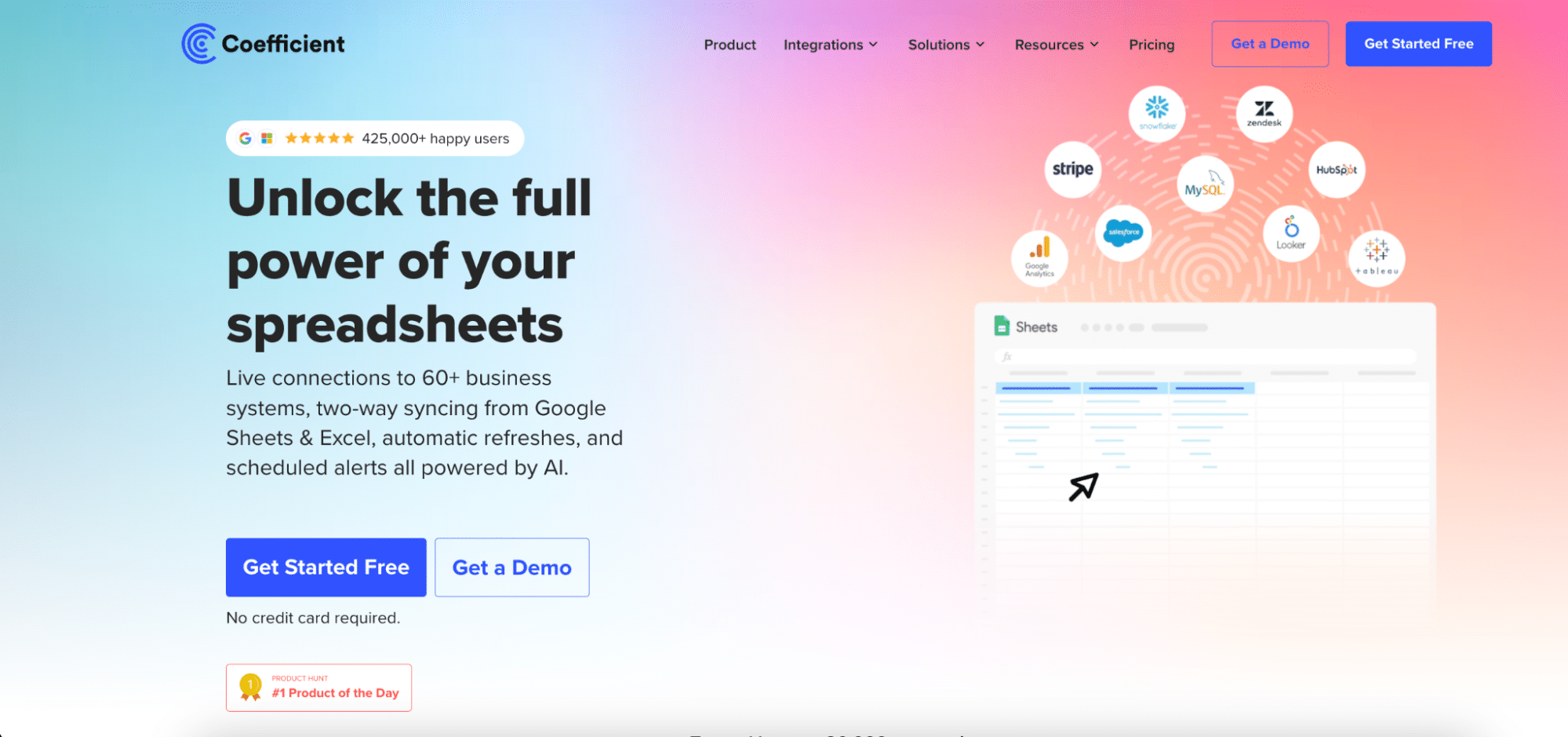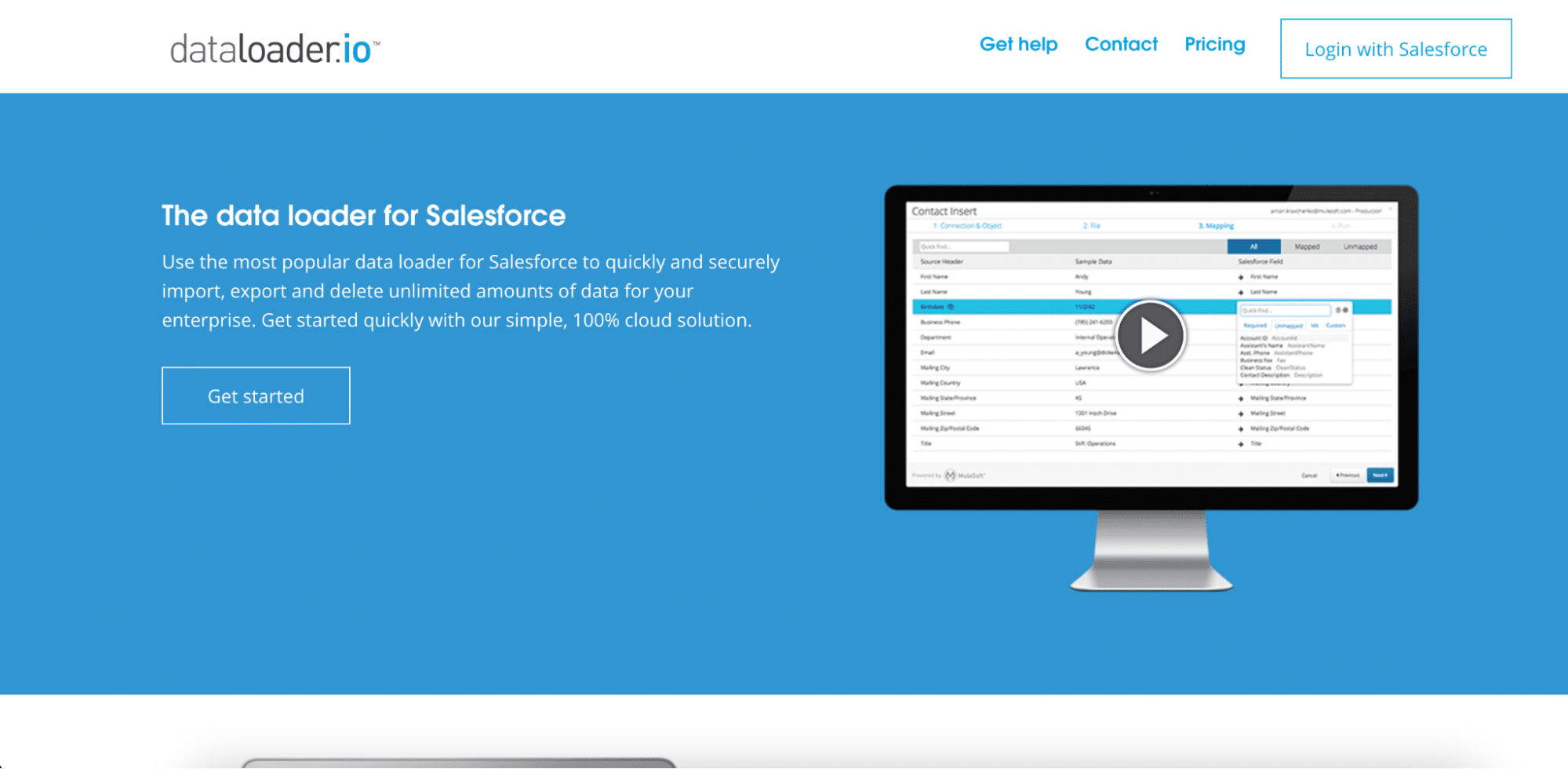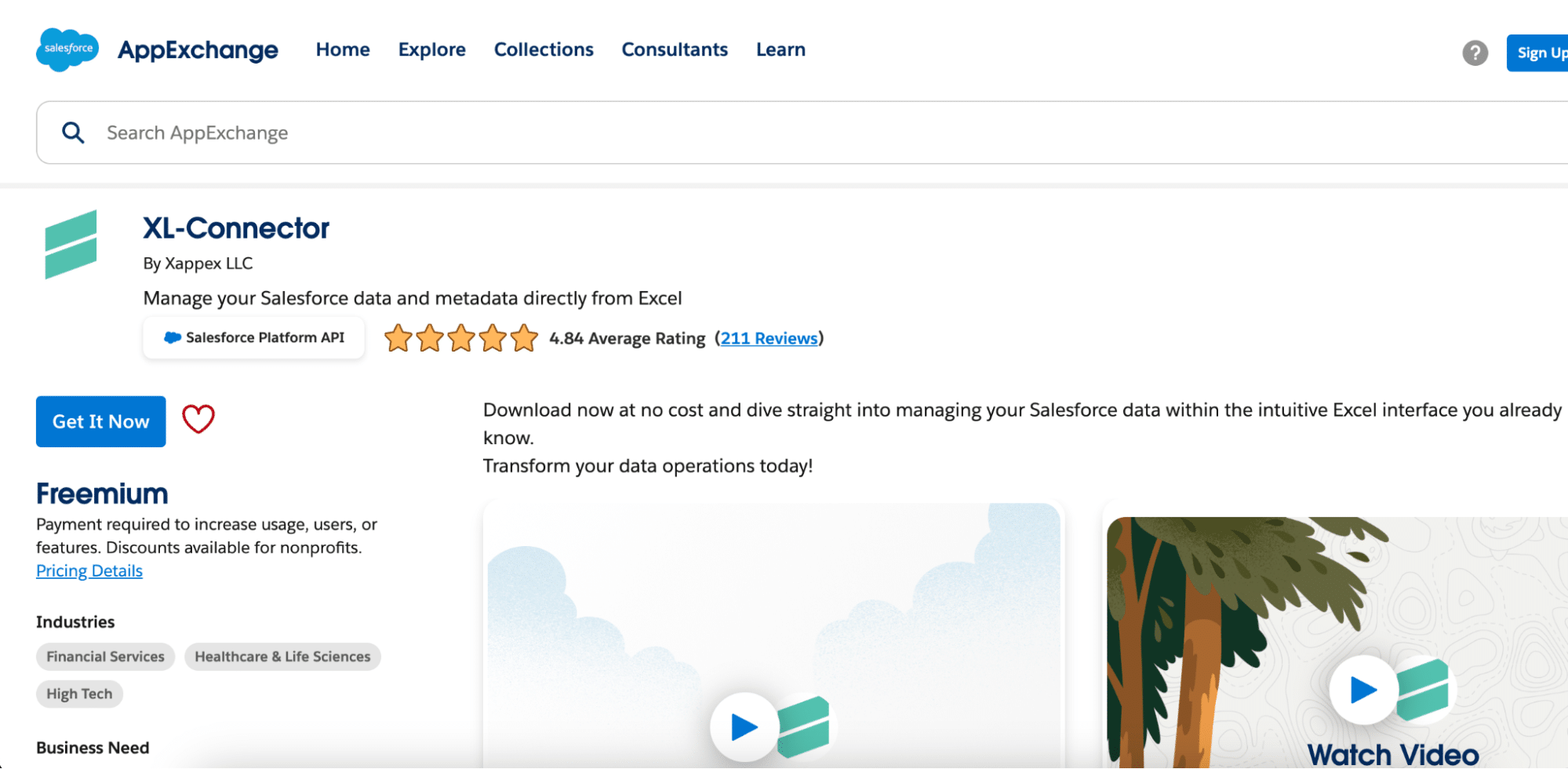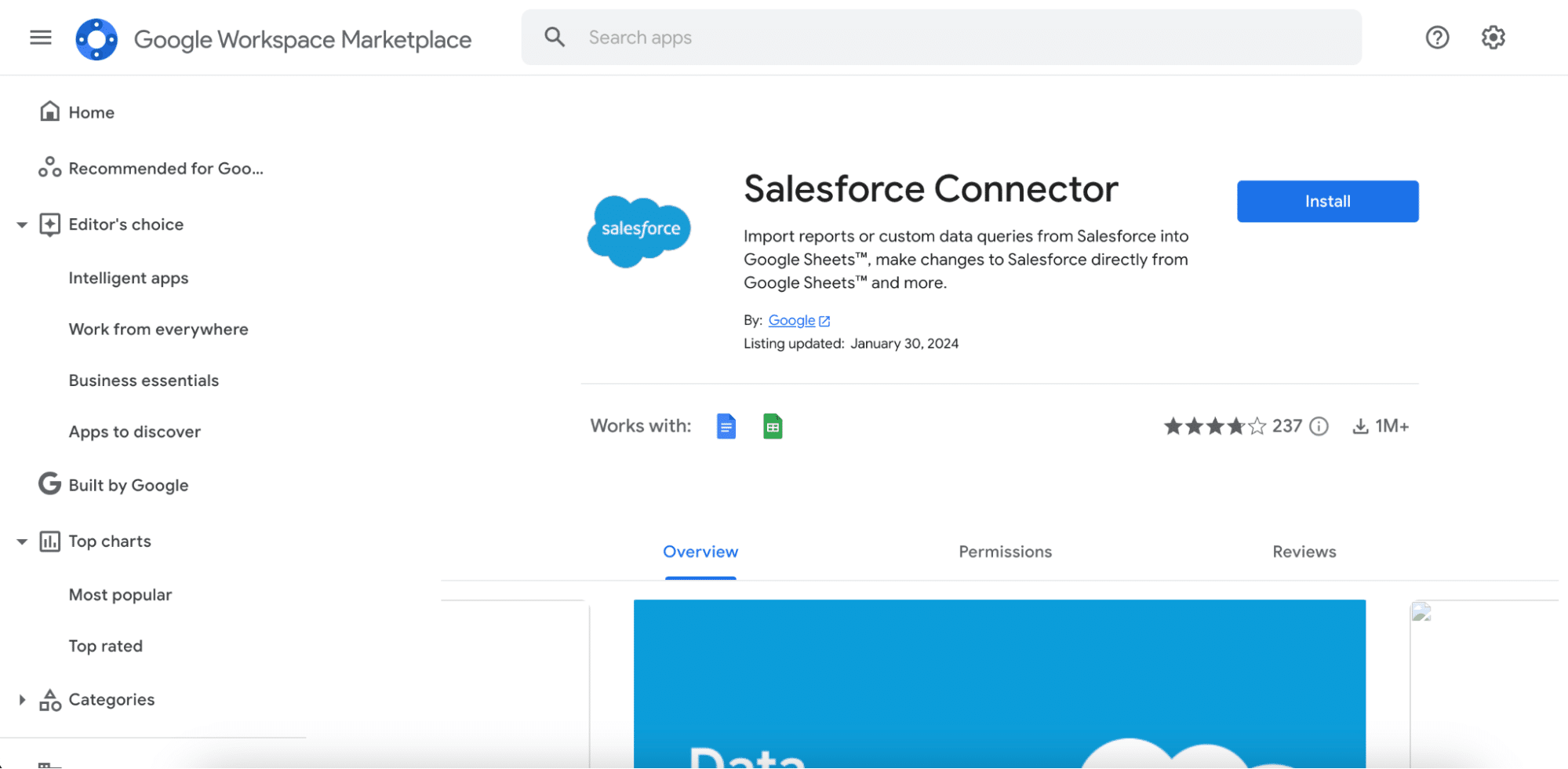Managing large volumes of data in Salesforce can be challenging. Data loaders for Salesforce simplify this process, improving efficiency and data accuracy. Here’s a look at the top Salesforce data loaders for 2024.
Feature Comparison Table of Top Data Loaders for Salesforce
| Feature | Coefficient | Salesforce Data Import Wizard | Dataloader.io | XL-Connector | Salesforce Google Data Connector |
| Row Limits / Export Limits | Unlimited | 50,000 records | 100,000 records (Free), Unlimited (Paid) | Unlimited | 2,000 rows |
| Data Sources | 50+ | Salesforce | Salesforce | Salesforce | Salesforce |
| Builder License Cost | $49/user/month | Free | $99/month | $20/user/month | Free |
| Viewer License Cost | Free | N/A | N/A | N/A | Free |
| AI Functionality | Yes | No | No | No | No |
| Refresh frequency | Real-time | Manual | Scheduled | Manual | Real-time |
| Alerts | Yes | No | No | No | No |
| Security | SOC 2 Type II | Salesforce native | SOC 2 Type II | Salesforce native | Google & Salesforce native |
1. Coefficient: The Ultimate Salesforce Data Loader

Coefficient stands out as a powerful data loader for Salesforce, offering seamless integration with Google Sheets and Excel. Its real-time data syncing and advanced automation features make it an indispensable tool for Salesforce users looking to improve their data management processes.
Highlights of Coefficient
- Real-time Salesforce data sync with spreadsheets
- AI-powered data cleaning and transformation
- Advanced automation for report distribution and alerts
Pros
- Intuitive Interface: Coefficient’s user-friendly design makes it accessible for both technical and non-technical users.
- Powerful Automation: Set up automatic data refreshes and alerts to keep your team informed and data up-to-date.
- Seamless Integration: Works flawlessly with Google Sheets and Excel, enhancing your existing workflow.
Cons
- Learning Curve: While user-friendly, mastering all features may take some time for new users.
- Pricing: Premium features may be costly for smaller organizations.
Pricing
As of April 2024, Coefficient offers a free plan with limited features. Paid plans start at $29/month for individuals and $49/user/month for teams. Enterprise pricing is available upon request.
What do users say about Coefficient?
Positive review: “Coefficient has transformed our Salesforce reporting. The real-time sync and automation features have saved us countless hours.” – John D., Sales Manager (Source: G2)
Critical review: “Great tool, but the learning curve can be steep for some of the more advanced features.” – Sarah L., Marketing Director (Source: Google Workspace)
Support
Coefficient offers comprehensive support including documentation, video tutorials, email support, and priority support for enterprise customers.
2. Salesforce Data Import Wizard: Native Salesforce Solution

The Salesforce Data Import Wizard is a built-in tool that allows users to import data directly into Salesforce. It’s an excellent option for those looking for a native solution without additional costs.
Highlights of Salesforce Data Import Wizard
- Native Salesforce tool
- User-friendly interface for basic data imports
Pros
- Cost-Effective: Included with Salesforce licenses at no additional cost.
- Ease of Use: Designed specifically for Salesforce, making it intuitive for users familiar with the platform.
Cons
- Limited Functionality: Lacks advanced features like automation and real-time syncing.
- Data Volume Restrictions: May not be suitable for large-scale data imports.
Pricing
Free with Salesforce licenses as of April 2024.
What do users say about Salesforce Data Import Wizard?
Positive review: “Great for quick, simple imports. It’s my go-to for small datasets.” – Mike R., Salesforce Admin (Source: Salesforce Trailblazer Community)
Critical review: “Works well for basic needs, but lacks advanced features for complex data management.” – Lisa T., CRM Specialist (Source: G2)
Support
Support is provided through Salesforce’s standard channels, including documentation and community forums.
3. Dataloader.io: Popular Cloud-Based Salesforce Data Loader

Dataloader.io is a widely-used cloud-based data loader for Salesforce, known for its user-friendly interface and robust features.
Highlights of Dataloader.io
- Cloud-based solution
- Support for large data volumes
Pros
- User-Friendly: Intuitive interface makes it easy for non-technical users to manage data.
- Flexibility: Supports various data operations including insert, update, upsert, and delete.
Cons
- Limited Free Version: The free version has restrictions on data volume and frequency of use.
- Dependence on Internet: Being cloud-based, it requires a stable internet connection.
Pricing
As of April 2024, Dataloader.io offers a free plan with limited features. Paid plans start at $99/month for additional features and higher data limits.
What do users say about Dataloader.io?
Positive review: “Dataloader.io has simplified our data management process. It’s reliable and easy to use.” – Alex K., Sales Ops Manager (Source: AppExchange)
Critical review: “While it’s great for most tasks, we sometimes hit limits with very large datasets.” – Chris M., IT Director (Source: G2)
Support
Dataloader.io provides email support, documentation, and a knowledge base for users.
4. XL-Connector: Excel-Centric Salesforce Data Management

XL-Connector is an Excel-based solution for managing Salesforce data, offering a familiar interface for users comfortable with spreadsheets.
Highlights of XL-Connector
- Deep Excel integration
- Supports complex Excel formulas and functions
Pros
- Excel Familiarity: Leverage existing Excel skills for Salesforce data management.
- Offline Capability: Work on data offline and sync when connected.
Cons
- Limited to Excel: Not suitable for organizations using other spreadsheet tools.
- Learning Curve: May require time to master advanced features.
Pricing
As of April 2024, XL-Connector offers a 14-day free trial. Paid plans start at $20/month per user.
What do users say about XL-Connector?
Positive review: “XL-Connector has streamlined our Salesforce data management. It’s a game-changer for Excel users.” – Emma S., Business Analyst (Source: AppExchange)
Critical review: “Great for Excel users, but we found it limiting when collaborating with team members who prefer other tools.” – David R., Sales Manager (Source: G2)
Support
XL-Connector provides email support, documentation, and video tutorials.
5. Salesforce Google Data Connector: Native Google Sheets Integration

The Salesforce Google Data Connector provides a native integration between Salesforce and Google Sheets, allowing for seamless data transfer between the two platforms.
Highlights of Salesforce Google Data Connector
- Native integration with Google Sheets
- Real-time data sync capabilities
Pros
- Google Workspace Integration: Ideal for organizations heavily invested in Google’s ecosystem.
- Real-Time Updates: Changes in Salesforce reflect immediately in connected Google Sheets.
Cons
- Limited Customization: Fewer options for data transformation compared to some third-party tools.
- Google Sheets Dependency: Not suitable for organizations primarily using Excel or other spreadsheet tools.
- No Support: Support was sunset for this data loader in Fall of 2024.
Pricing
Free with Salesforce and Google Workspace licenses as of April 2024.
What do users say about Salesforce Google Data Connector?
Positive review: “The direct integration between Salesforce and Google Sheets has greatly improved our reporting workflow.” – Rachel K., Operations Manager (Source: G2)
Critical review: “While it’s great for basic needs, we found it lacking some advanced features for complex data management.” – Tom L., IT Specialist (Source: Salesforce Trailblazer Community)
Support
Sunset in fall of 2024.
Making the Right Data Loader Choice
Selecting the right data loader for Salesforce can significantly impact your data management efficiency and accuracy. While native solutions like the Salesforce Data Import Wizard and Google Data Connector offer basic functionality, third-party tools like Coefficient provide advanced features such as real-time syncing, automation, and AI-powered data cleaning.
Consider your specific needs, budget, and existing tech stack when making your decision. For organizations looking for a comprehensive solution that works with both Google Sheets and Excel, offers powerful automation, and provides real-time data syncing, Coefficient stands out as a top choice.
Ready to improve your Salesforce data management? Get started with Coefficient today and experience the difference in your data workflows.
Frequently Asked Questions
What is the best free data loader for Salesforce?
The Salesforce Data Import Wizard is the best free option for basic data loading needs. However, for more advanced features without cost, Coefficient offers a free plan that includes real-time syncing and basic automation capabilities.
How do I use Data Loader in Salesforce?
To use the native Salesforce Data Loader:
- Download and install the Data Loader from Salesforce.
- Log in to your Salesforce account through the Data Loader.
- Choose your operation (insert, update, upsert, delete, or export).
- Select your data file and map the fields.
- Run the operation and review the results.
For a more user-friendly experience with advanced features, consider using Coefficient, which offers an intuitive interface and real-time syncing capabilities.
Is dataloader.io owned by Salesforce?
No, dataloader.io is not owned by Salesforce. It’s a third-party tool created by MuleSoft, which is now a part of Salesforce. However, for a fully integrated solution, Coefficient offers seamless Salesforce data management with additional features like AI-powered insights and advanced automation.
What’s the difference between dataloader.io and Salesforce Data Loader?
Dataloader.io is a cloud-based tool offering a user-friendly interface and support for large data volumes. Salesforce Data Loader is a native desktop application with basic import/export capabilities. For a solution that combines the best of both worlds – cloud-based convenience and powerful features – consider using Coefficient for your Salesforce data management needs.





